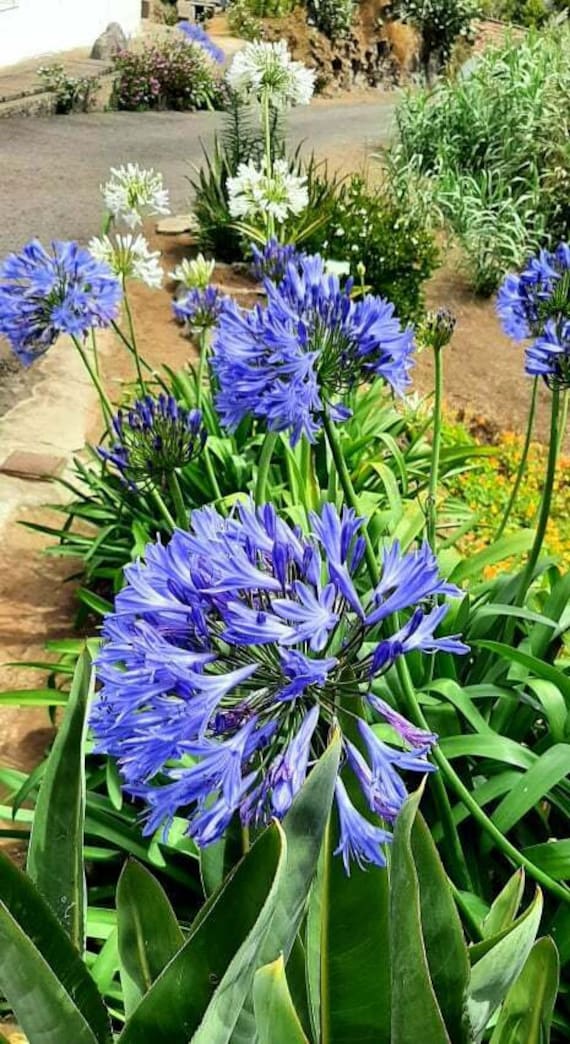Typical Agapanthus Problems and Just How to Address Them
Typical Agapanthus Problems and Just How to Address Them
Blog Article
Unleashing the Secret to Effective Agapanthus Growing: Idea for a Flourishing Garden
In the world of horticulture, growing agapanthus successfully calls for a calculated technique that incorporates numerous aspects of plant treatment. With cautious attention to information, one can unlock the secrets to supporting these magnificent blooms, bring about a garden that grows with beauty and vibrancy. By recognizing the nuances of agapanthus cultivation, one can produce an environment where these plants prosper and flower abundantly. In the following conversation, we will explore crucial pointers and techniques that will assist you towards a flourishing agapanthus garden, supplying insights into ideal practices, dirt problems, sprinkling methods, and more.
Growing Agapanthus: Ideal Practices
When growing Agapanthus, proper soil preparation is necessary for guaranteeing effective development and growth of these attractive blossoms. Agapanthus, generally referred to as Lily of the Nile or African lily, thrives in well-draining soil with a somewhat acidic to neutral pH level - Agapanthus. Prior to planting, it is crucial to amend hefty clay dirts with raw material such as compost or peat moss to enhance drain and give essential nutrients for the plants
To grow Agapanthus, select a location that gets full sunshine to partial color, as this will certainly advertise healthy development and abundant blooming. Dig a hole two times the diameter of the plant's root ball and place the Agapanthus at the same deepness it was formerly growing. Gently backfill the hole with dirt, pushing down securely to eliminate any air pockets around the roots.
Water the newly planted Agapanthus thoroughly and continue to keep the soil equally wet, particularly during the plant's active expanding period. Agapanthus. Applying a balanced fertilizer once a month can even more support the plant's development and flowering. By adhering to these ideal techniques for planting Agapanthus, you can produce a sensational display of these captivating flowers in your yard
Suitable Soil Conditions for Agapanthus
For optimal development and blooming success of Agapanthus plants, making sure the dirt conditions are suitable is crucial. Agapanthus favors soil that is abundant in nutrients, so incorporating a balanced plant food throughout the growing season can advertise healthy growth and vivid blooms.

Watering and Fertilizing Tips
To ensure healthy growth and dynamic flowers, appropriate watering and fertilizing techniques are necessary for Get More Info effective Agapanthus farming. Agapanthus plants gain from normal watering, specifically throughout the expanding period. It is advised more tips here to water deeply when a week, making certain the dirt is wet yet not saturated. Throughout warm weather condition or in pots, more constant watering may be necessary to avoid the dirt from drying entirely.
When it pertains to fertilizing Agapanthus, a balanced fertilizer with equivalent parts nitrogen, phosphorus, and potassium can be used in the spring to promote healthy and balanced development and flowering. Slow-release plant foods are optimal for offering nutrients progressively over a prolonged duration. Prevent over-fertilizing, as this can result in excessive vegetation growth at the cost of blooms.
In addition, including organic matter like garden compost right into the soil can boost nutrient levels and enhance dirt framework, helping in the overall wellness of the Agapanthus plants. By complying with these watering and feeding suggestions, gardeners can guarantee their Agapanthus plants grow and create stunning displays of blossoms.
Trimming and Deadheading Techniques
Appropriate trimming and deadheading techniques play an essential function in keeping the health and wellness and appearances of Agapanthus plants, matching the crucial techniques of watering and feeding for successful farming. Pruning Agapanthus entails removing spent flower heads, dead or yellowing leaves, and total shaping of the plant to advertise far better growth. Deadheading, the process of eliminating discolored flowers, not just boosts the plant's appearance however additionally motivates more blooming.
When deadheading Agapanthus, it is recommended to snip off the flower stem at the base making use of sharp, tidy shears. This procedure reroutes the plant's power from seed manufacturing back right into root and vegetation development, advertising a healthier and much more durable plant. Normal deadheading can extend the blooming duration of Agapanthus and prevent self-seeding, which can lead to congestion.
In terms of trimming, Agapanthus usually gain from a light trim after blossoming to clean up the plant and motivate fresh development. Reducing the invested blossom stems and removing any kind of damaged or dead vegetation assists keep the plant's vigor and overall appearance. Nevertheless, it is important to prevent cutting into the crown of the plant, as this can deteriorate its wellness.

Protecting Agapanthus From Pests and Diseases
Executing effective parasite and illness management approaches is essential to guarding the health and wellness and vitality of Agapanthus plants in farming. One typical insect that influences Agapanthus is the Agapanthus borer, a caterpillar that passages into the plant, triggering damages to the leaves and blossoms.
In addition to bugs, site web Agapanthus are at risk to diseases such as origin rot and fungal fallen leave spots. By staying attentive and resolving bug and illness concerns promptly, gardeners can assist their Agapanthus flourish and grow.

Verdict
Finally, successful cultivation of agapanthus requires appropriate planting strategies, optimal dirt problems, sufficient watering and feeding, routine trimming and deadheading, and security from bugs and illness. By complying with these tricks and suggestions, gardeners can ensure a flourishing garden loaded with gorgeous agapanthus flowers. Agapanthus. Keep in mind to preserve consistent care and focus to information to advertise the health and wellness and longevity of these stunning plants
When growing Agapanthus, correct dirt preparation is crucial for making certain effective growth and development of these beautiful blossoms.Water the recently planted Agapanthus thoroughly and proceed to keep the soil uniformly wet, specifically throughout the plant's active growing season.For ideal development and flowering success of Agapanthus plants, ensuring the dirt problems are optimal is essential. When growing or hair transplanting Agapanthus, ensure the soil is well-prepared to provide the necessary structure for the plants to establish themselves effectively. One typical pest that influences Agapanthus is the Agapanthus borer, a caterpillar that tunnels right into the plant, triggering damage to the leaves and flowers.
Report this page